Whole Genome Resequencing Revealed the Effect of Helicase yqhH Gene on Regulating Bacillus thuringiensis LLP29 against Ultraviolet Radiation Stress
Abstract
1. Introduction
2. Results
2.1. Sequencing Quality Control and Assembly of Bt LLP29-M19
2.2. Differential Analysis of Resequencing Results
2.3. Functional Annotation of Variant Genes at the DNA Level
2.4. UV-Related Gene Screening
2.5. Cloning and Expression of yqhH Gene
2.6. ATP Hydrolysis Activity of yqhH Helicase
2.7. Unwinding Activity of yqhH Helicase
2.8. Knocking out yqhH in Bt LLP29
2.9. Complementation of yqhH in Bt LLP29-ΔyqhH
2.10. Growth Curves and UV-B Treatment Phenotype
2.11. Unwinding Activity In Vivo
3. Discussion
4. Materials and Methods
4.1. Tested Strains
4.2. Sequencing, Assembly and Analysis of Genome Sequences
4.3. Cloning, Expression, and Purification of yqhH
4.4. ATPase Activity Assay
4.5. Unwinding Activity Assay
4.6. Construction of the Gene Knockout Vector
4.7. Preparation and Transformation of Bt LLP29 Competent Cells
4.8. Homologous Recombination and Identification
4.9. Construction and Verification of yqhH Deletion Complementary Strain
4.10. Growth Curve Assay
4.11. UV-B Treatment Experiment
Supplementary Materials
Author Contributions
Funding
Institutional Review Board Statement
Informed Consent Statement
Data Availability Statement
Acknowledgments
Conflicts of Interest
References
- Lemaux, P.G. Genetically Engineered Plants and Foods: A Scientist’s Analysis of the Issues (Part I). Annu. Rev. Plant Biol. 2008, 59, 771–812. [Google Scholar] [CrossRef] [PubMed]
- Höfte, H.; Whiteley, H.R. Insecticidal crystal proteins of Bacillus thuringiensis. Microbiol. Rev. 1989, 53, 242–255. [Google Scholar] [CrossRef] [PubMed]
- Zhang, L.; Zhang, X.; Zhang, Y.; Wu, S.; Gelbič, I.; Xu, L.; Guan, X. A new formulation of Bacillus thuringiensis: UV protection and sustained release mosquito larvae studies. Sci. Rep. 2016, 6, 39425. [Google Scholar] [CrossRef] [PubMed]
- Letowski, J.; Bravo, A.; Brousseau, R.; Masson, L. Assessment of cry1 gene contents of Bacillus thuringiensis strains by use of DNA microarrays. Appl. Environ. Microbiol. 2005, 71, 5391–5398. [Google Scholar] [CrossRef] [PubMed]
- Chakrabarty, S.; Jin, M.; Wu, C.; Chakraborty, P. Bacillus thuringiensis vegetative insecticidal protein family Vip3A and mode of action against pest Lepidoptera. Pest Manag. Sci. 2020, 76, 1612–1617. [Google Scholar] [CrossRef] [PubMed]
- Chakrabarty, S.; Chakraborty, P.; Islam, T.; Aminul Islam, A.K.M.; Datta, J.; Bhattacharjee, T.; Minghui, J.; Xiao, Y. Bacillus thuringiensis proteins: Structure, mechanism and biological control of insect pests. In Bacilli and Agrobiotechnology: Plant Stress Tolerance, Bioremediation, and Bioprospecting; Springer Nature: Cham, Switzerland, 2022. [Google Scholar]
- Pozsgay, M.; Fast, P.; Kaplan, H.; Carey, P.R. The effect of sunlight on the protein crystals from Bacillus thuringiensis var. kurstaki HD1 and NRD12: A Raman spectroscopic study. J. Invertebr. Pathol. 1987, 50, 246–253. [Google Scholar] [CrossRef]
- Zhang, L.; Zhang, X.; Batool, K.; Hu, X.; Chen, M.; Xu, J.; Wang, J.; Pan, X.; Huang, T.; Xu, L.; et al. Comparison and Mechanism of the UV-Resistant Mosquitocidal Bt Mutant LLP29-M19. J. Med. Entomol. 2018, 55, 210–216. [Google Scholar] [CrossRef] [PubMed]
- Ruan, L.; Yu, Z.; Fang, B.; He, W.; Wang, Y.; Shen, P. Melanin pigment formation and increased UV resistance in Bacillus thuringiensis following high temperature induction. Syst. Appl. Microbiol. 2004, 27, 286–289. [Google Scholar] [CrossRef] [PubMed]
- Cao, Z.L.; Tan, T.T.; Jiang, K.; Mei, S.Q.; Hou, X.Y.; Cai, J. Complete genome sequence of Bacillus thuringiensis L-7601, a wild strain with high production of melanin. J. Biotechnol. 2018, 275, 40–43. [Google Scholar] [CrossRef]
- Nishito, Y.; Osana, Y.; Hachiya, T.; Popendorf, K.; Toyoda, A.; Fujiyama, A.; Itaya, M.; Sakakibara, Y. Whole genome assembly of a natto production strain Bacillus subtilis natto from very short read data. BMC Genom. 2010, 11, 243. [Google Scholar] [CrossRef]
- Dong, Z.; Alam, M.K.; Xie, M.; Yang, L. Mapping of a major QTL controlling plant height using a high-density genetic map and QTL-seq methods based on whole-genome resequencing in Brassica napus. G3 2021, 11, jkab118. [Google Scholar] [CrossRef] [PubMed]
- Hollensteiner, J.; Poehlein, A.; Sproer, C.; Bunk, B.; Sheppard, A.E.; Rosenstiel, P.; Schulenburg, H.; Liesegang, H. Complete genome sequence of the nematicidal Bacillus thuringiensis MYBT18247. J. Biotechnol. 2017, 260, 48–52. [Google Scholar] [CrossRef] [PubMed]
- Li, Q.; Zou, T.; Ai, P.; Pan, L.; Fu, C.; Li, P.; Zheng, A. Complete genome sequence of Bacillus thuringiensis HS18-1. J. Biotechnol. 2015, 214, 61–62. [Google Scholar] [CrossRef] [PubMed]
- Zhang, J.T.; Yan, J.P.; Zheng, D.S.; Sun, Y.J.; Yuan, Z.M. Expression of mel gene improves the UV resistance of Bacillus thuringiensis. J. Appl. Microbiol. 2008, 105, 151–157. [Google Scholar] [CrossRef]
- Sansinenea, E.; Salazar, F.; Ramirez, M.; Ortiz, A. An Ultra-Violet Tolerant Wild-Type Strain of Melanin-Producing Bacillus thuringiensis. Jundishapur J. Microbiol. 2015, 8, e20910. [Google Scholar] [CrossRef]
- Zhu, L.; Chu, Y.; Zhang, B.; Yuan, X.; Wang, K.; Liu, Z.; Sun, M. Creation of an Industrial Bacillus thuringiensis Strain With High Melanin Production and UV Tolerance by Gene Editing. Front. Microbiol. 2022, 13, 913715. [Google Scholar] [CrossRef]
- Xue, L.; Zhang, Y.; Zhang, T.; An, L.; Wang, X. Effects of enhanced ultraviolet-B radiation on algae and cyanobacteria. Crit. Rev. Microbiol. 2005, 31, 79–89. [Google Scholar] [CrossRef]
- Gao, Q.; Garcia-Pichel, F. Microbial ultraviolet sunscreens. Nat. Rev. Microbiol. 2011, 9, 791–802. [Google Scholar] [CrossRef]
- Enemark, E.J.; Joshua-Tor, L. On helicases and other motor proteins. Curr. Opin. Struct. Biol. 2008, 18, 243–257. [Google Scholar] [CrossRef] [PubMed]
- Lohman, T.M.; Tomko, E.J.; Wu, C.G. Non-hexameric DNA helicases and translocases: Mechanisms and regulation. Nat. Rev. Mol. Cell Biol. 2008, 9, 391–401. [Google Scholar] [CrossRef] [PubMed]
- Rezazadeh, S. RecQ helicases; at the crossroad of genome replication, repair, and recombination. Mol. Biol. Rep. 2012, 39, 4527–4543. [Google Scholar] [CrossRef]
- Bernstein, K.A.; Gangloff, S.; Rothstein, R. The RecQ DNA helicases in DNA repair. Annu. Rev. Genet. 2010, 44, 393–417. [Google Scholar] [CrossRef] [PubMed]
- Sharma, S.; Doherty, K.M.; Brosh, R.M., Jr. Mechanisms of RecQ helicases in pathways of DNA metabolism and maintenance of genomic stability. Biochem. J. 2006, 398, 319–337. [Google Scholar] [CrossRef] [PubMed]
- Gorbalenya, A.E.; Koonin, E.V. Helicases: Amino acid sequence comparisons and structure-function relationships. Curr. Opin. Struct. Biol. 1993, 3, 419–429. [Google Scholar] [CrossRef]
- Patel, S.S.; Picha, K.M. Structure and function of hexameric helicases. Annu. Rev. Biochem. 2000, 69, 651–697. [Google Scholar] [CrossRef]
- Beyene, G.T.; Balasingham, S.V.; Frye, S.A.; Namouchi, A.; Homberset, H.; Kalayou, S.; Riaz, T.; Tønjum, T. Characterization of the Neisseria meningitidis Helicase RecG. PLoS ONE 2016, 11, e0164588. [Google Scholar] [CrossRef]
- Steiner, P.; Sauer, U. Overexpression of the ATP-dependent helicase RecG improves resistance to weak organic acids in Escherichia coli. Appl. Microbiol. Biotechnol. 2003, 63, 293–299. [Google Scholar] [CrossRef]
- Torres, R.; Romero, H.; Rodríguez-Cerrato, V.; Alonso, J.C. Interplay between Bacillus subtilis RecD2 and the RecG or RuvAB helicase in recombinational repair. DNA Repair 2017, 55, 40–46. [Google Scholar] [CrossRef]
- Yeom, J.; Lee, Y.; Park, W. ATP-dependent RecG helicase is required for the transcriptional regulator OxyR function in Pseudomonas species. J. Biol. Chem. 2012, 287, 24492–24504. [Google Scholar] [CrossRef]
- Xu, J.; Wu, C.; Yang, Z.; Liu, W.; Chen, H.; Batool, K.; Yao, J.; Fan, X.; Wu, J.; Rao, W.; et al. For: Pesticide biochemistry and physiology recG is involved with the resistance of Bt to UV. Pestic. Biochem. Physiol. 2020, 167, 104599. [Google Scholar] [CrossRef]
- Pandiani, F.; Chamot, S.; Brillard, J.; Carlin, F.; Nguyen-the, C.; Broussolle, V. Role of the five RNA helicases in the adaptive response of Bacillus cereus ATCC 14579 cells to temperature, pH, and oxidative stresses. Appl. Environ. Microbiol. 2011, 77, 5604–5609. [Google Scholar] [CrossRef]
- Français, M.; Carlin, F.; Broussolle, V.; Nguyen-Thé, C. Bacillus cereus cshA Is Expressed during the Lag Phase of Growth and Serves as a Potential Marker of Early Adaptation to Low Temperature and pH. Appl. Environ. Microbiol. 2019, 85, e00486-19. [Google Scholar] [CrossRef]
- Newman, J.A.; Gileadi, O. RecQ helicases in DNA repair and cancer targets. Essays Biochem. 2020, 64, 819–830. [Google Scholar] [CrossRef]
- Moreno-Del Alamo, M.; Torres, R.; Manfredi, C.; Ruiz-Masó, J.A.; Del Solar, G.; Alonso, J.C. Bacillus subtilis PcrA Couples DNA Replication, Transcription, Recombination and Segregation. Front. Mol. Biosci. 2020, 7, 140. [Google Scholar] [CrossRef]
- Jalali, E.; Maghsoudi, S.; Noroozian, E. Ultraviolet protection of Bacillus thuringiensis through microencapsulation with Pickering emulsion method. Sci. Rep. 2020, 10, 20633. [Google Scholar] [CrossRef] [PubMed]
- Bansal, V. A statistical method for the detection of variants from next-generation resequencing of DNA pools. Bioinformatics 2010, 26, i318–i324. [Google Scholar] [CrossRef] [PubMed]
- Yang, Q.; Yang, Y.; Tang, Y.; Wang, X.; Chen, Y.; Shen, W.; Zhan, Y.; Gao, J.; Wu, B.; He, M.; et al. Development and characterization of acidic-pH-tolerant mutants of Zymomonas mobilis through adaptation and next-generation sequencing-based genome resequencing and RNA-Seq. Biotechnol. Biofuels 2020, 13, 144. [Google Scholar] [CrossRef] [PubMed]
- Chen, H.; Zeng, X.; Yang, J.; Cai, X.; Shi, Y.; Zheng, R.; Wang, Z.; Liu, J.; Yi, X.; Xiao, S.; et al. Whole-genome resequencing of Osmanthus fragrans provides insights into flower color evolution. Hortic. Res. 2021, 8, 98. [Google Scholar] [CrossRef] [PubMed]
- Slade, D.; Radman, M. Oxidative stress resistance in Deinococcus radiodurans. Microbiol. Mol. Biol. Rev. 2011, 75, 133–191. [Google Scholar] [CrossRef] [PubMed]
- Dillingham, M.S. Superfamily I helicases as modular components of DNA-processing machines. Biochem. Soc. Trans. 2011, 39, 413–423. [Google Scholar] [CrossRef] [PubMed]
- Moreno-Del Álamo, M.; Carrasco, B.; Torres, R. Bacillus subtilis PcrA Helicase Removes Trafficking Barriers. Cells 2021, 10, 935. [Google Scholar] [CrossRef]
- Tuteja, N.; Tuteja, R. Prokaryotic and eukaryotic DNA helicases. Essential molecular motor proteins for cellular machinery. Eur. J. Biochem. 2004, 271, 1835–1848. [Google Scholar] [CrossRef] [PubMed]
- Qin, W.; Liu, N.N.; Wang, L.; Zhou, M.; Ren, H.; Bugnard, E.; Liu, J.L.; Zhang, L.H.; Vendôme, J.; Hu, J.S.; et al. Characterization of biochemical properties of Bacillus subtilis RecQ helicase. J. Bacteriol. 2014, 196, 4216–4228. [Google Scholar] [CrossRef] [PubMed]
- Tortosa, P.; Albano, M.; Dubnau, D. Characterization of ylbF, a new gene involved in competence development and sporulation in Bacillus subtilis. Mol. Microbiol. 2000, 35, 1110–1119. [Google Scholar] [CrossRef] [PubMed]
- Huber, K.E.; Waldor, M.K. Filamentous phage integration requires the host recombinases XerC and XerD. Nature 2002, 417, 656–659. [Google Scholar] [CrossRef] [PubMed]
- Jouan, L.; Szatmari, G. Interactions of the Caulobacter crescentus XerC and XerD recombinases with the E. coli dif site. FEMS Microbiol. Lett. 2003, 222, 257–262. [Google Scholar] [CrossRef]
- Zhang, L.; Huang, E.; Lin, J.; Gelbic, I.; Zhang, Q.; Guan, Y.; Huang, T.; Guan, X. A novel mosquitocidal Bacillus thuringiensis strain LLP29 isolated from the phylloplane of Magnolia denudata. Microbiol. Res. 2010, 165, 133–141. [Google Scholar] [CrossRef]
- Li, H.; Durbin, R. Fast and accurate short read alignment with Burrows-Wheeler transform. Bioinformatics 2009, 25, 1754–1760. [Google Scholar] [CrossRef]
- McKenna, A.; Hanna, M.; Banks, E.; Sivachenko, A.; Cibulskis, K.; Kernytsky, A.; Garimella, K.; Altshuler, D.; Gabriel, S.; Daly, M.; et al. The Genome Analysis Toolkit: A MapReduce framework for analyzing next-generation DNA sequencing data. Genome Res. 2010, 20, 1297–1303. [Google Scholar] [CrossRef]
- Cingolani, P.; Platts, A.; Wang le, L.; Coon, M.; Nguyen, T.; Wang, L.; Land, S.J.; Lu, X.; Ruden, D.M. A program for annotating and predicting the effects of single nucleotide polymorphisms, SnpEff: SNPs in the genome of Drosophila melanogaster strain w1118; iso-2; iso-3. Fly 2012, 6, 80–92. [Google Scholar] [CrossRef]
- Kanehisa, M.; Goto, S.; Kawashima, S.; Okuno, Y.; Hattori, M. The KEGG resource for deciphering the genome. Nucleic Acids Res. 2004, 32, D277–D280. [Google Scholar] [CrossRef]
- Ashburner, M.; Ball, C.A.; Blake, J.A.; Botstein, D.; Butler, H.; Cherry, J.M.; Davis, A.P.; Dolinski, K.; Dwight, S.S.; Eppig, J.T.; et al. Gene ontology: Tool for the unification of biology. The Gene Ontology Consortium. Nat. Genet. 2000, 25, 25–29. [Google Scholar] [CrossRef] [PubMed]
- Zhang, X.D.; Dou, S.X.; Xie, P.; Wang, P.Y.; Xi, X.G. RecQ helicase-catalyzed DNA unwinding detected by fluorescence resonance energy transfer. Acta Biochim. Biophys. Sin. 2005, 37, 593–600. [Google Scholar] [CrossRef] [PubMed]
- Bizebard, T.; Ferlenghi, I.; Iost, I.; Dreyfus, M. Studies on three E. coli DEAD-box helicases point to an unwinding mechanism different from that of model DNA helicases. Biochemistry 2004, 43, 7857–7866. [Google Scholar] [CrossRef] [PubMed]
- Li, X.; Zhang, X.; Hu, X.; Ding, X.; Xia, L.; Hu, S. Elaboration of an Electroporation Protocol for Bacillus Thuringiensis. J. Nat. Sci. Hunan Norm. Univ. 2013, 36, 63–67. [Google Scholar]
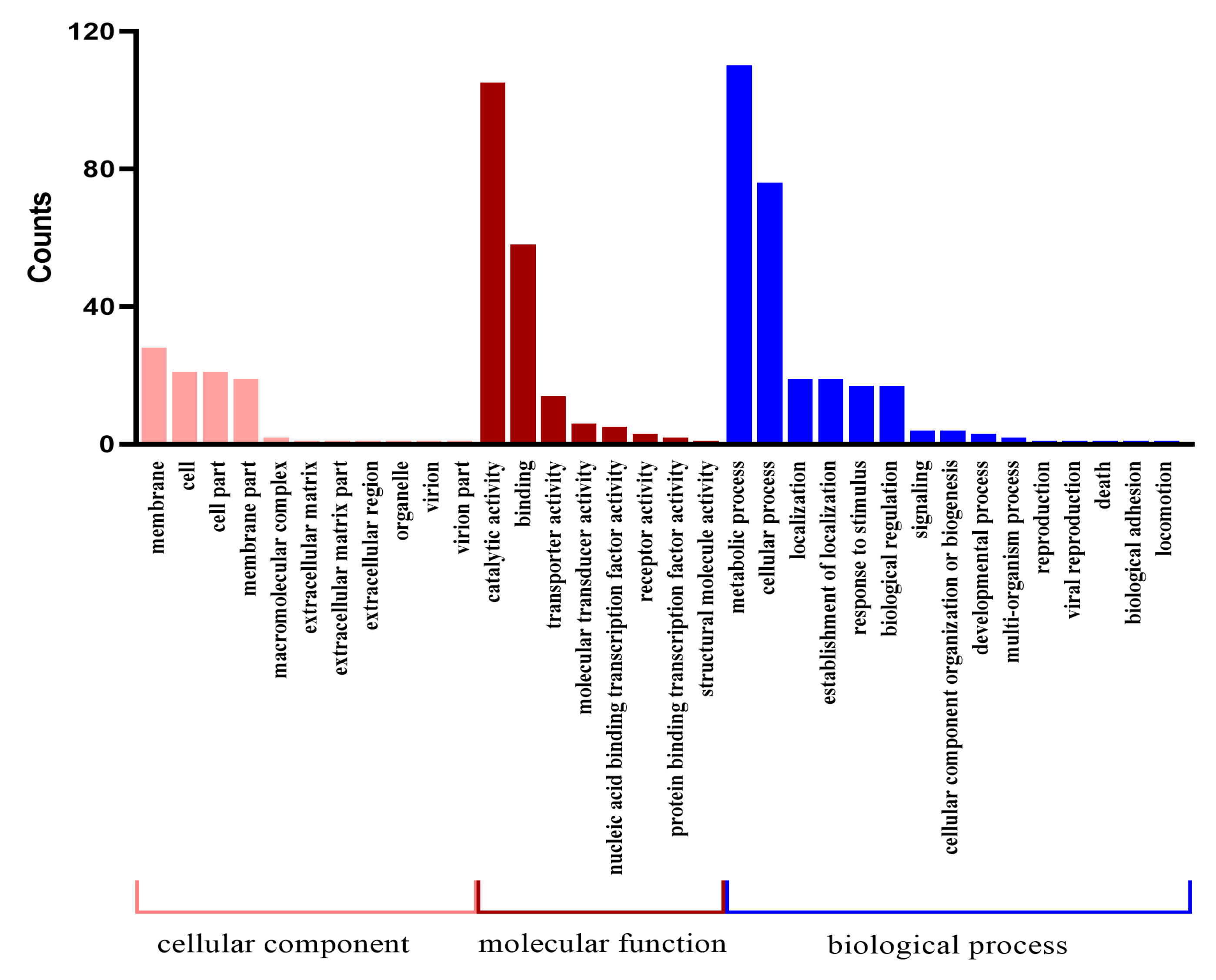
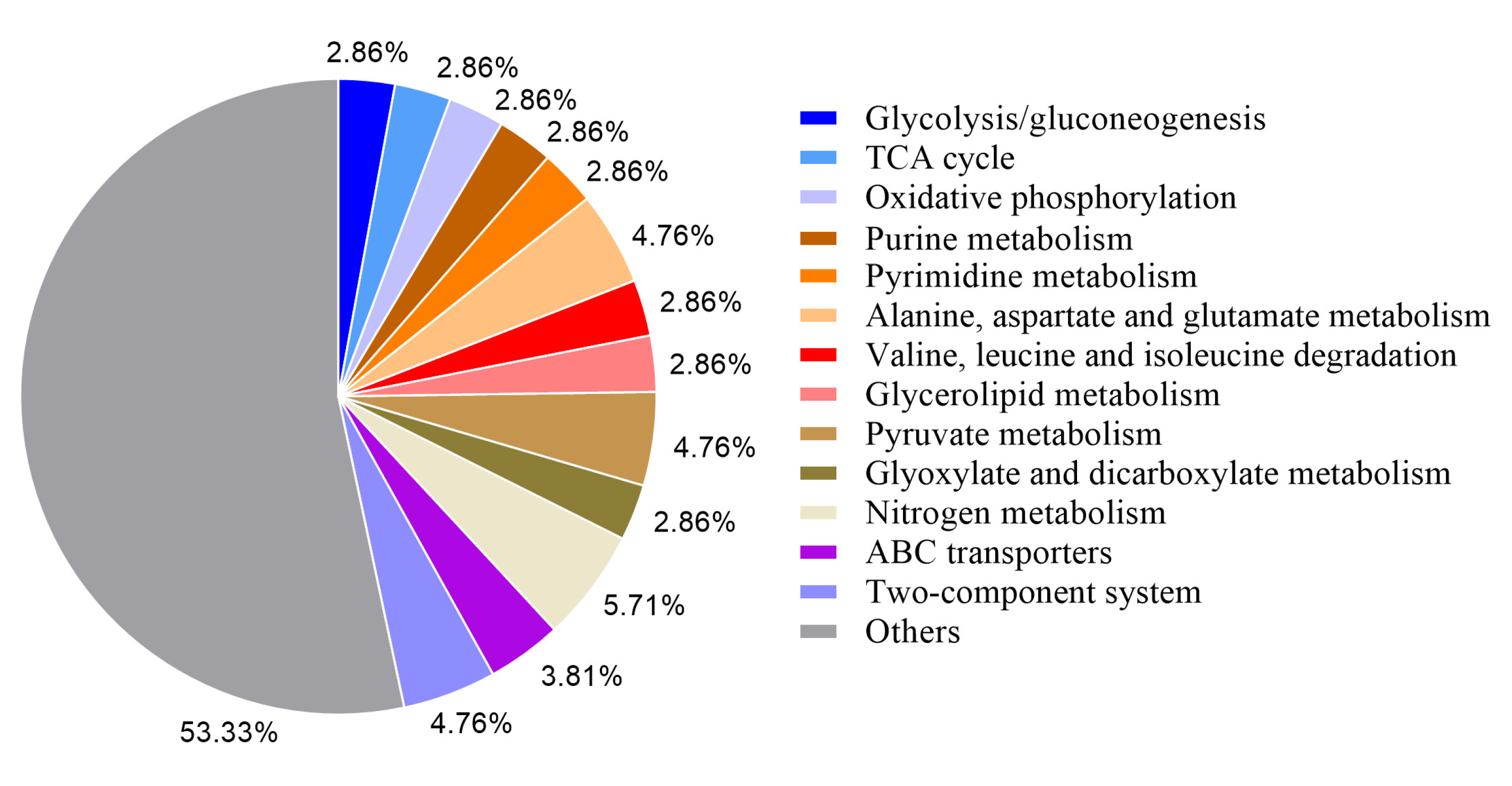
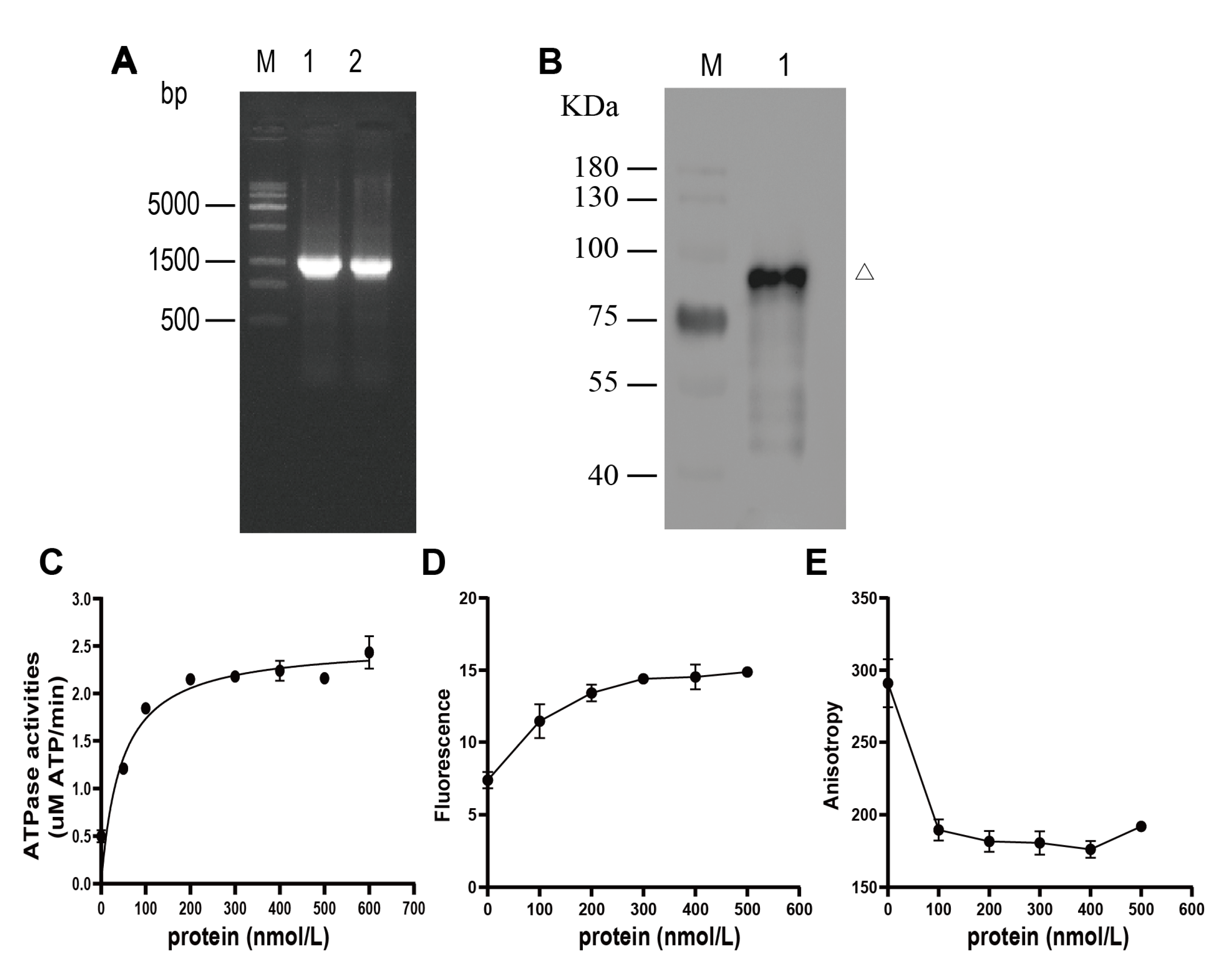
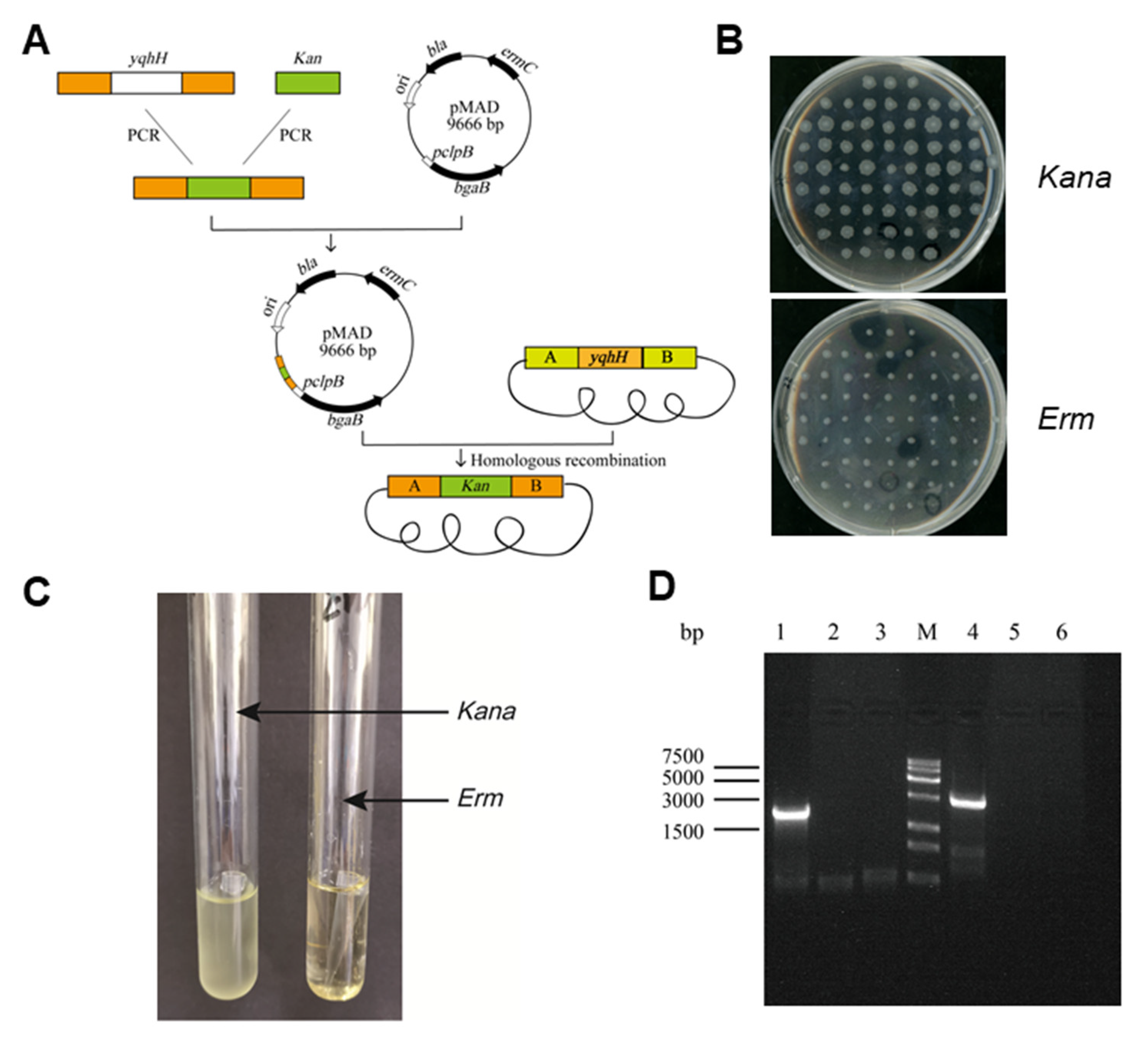
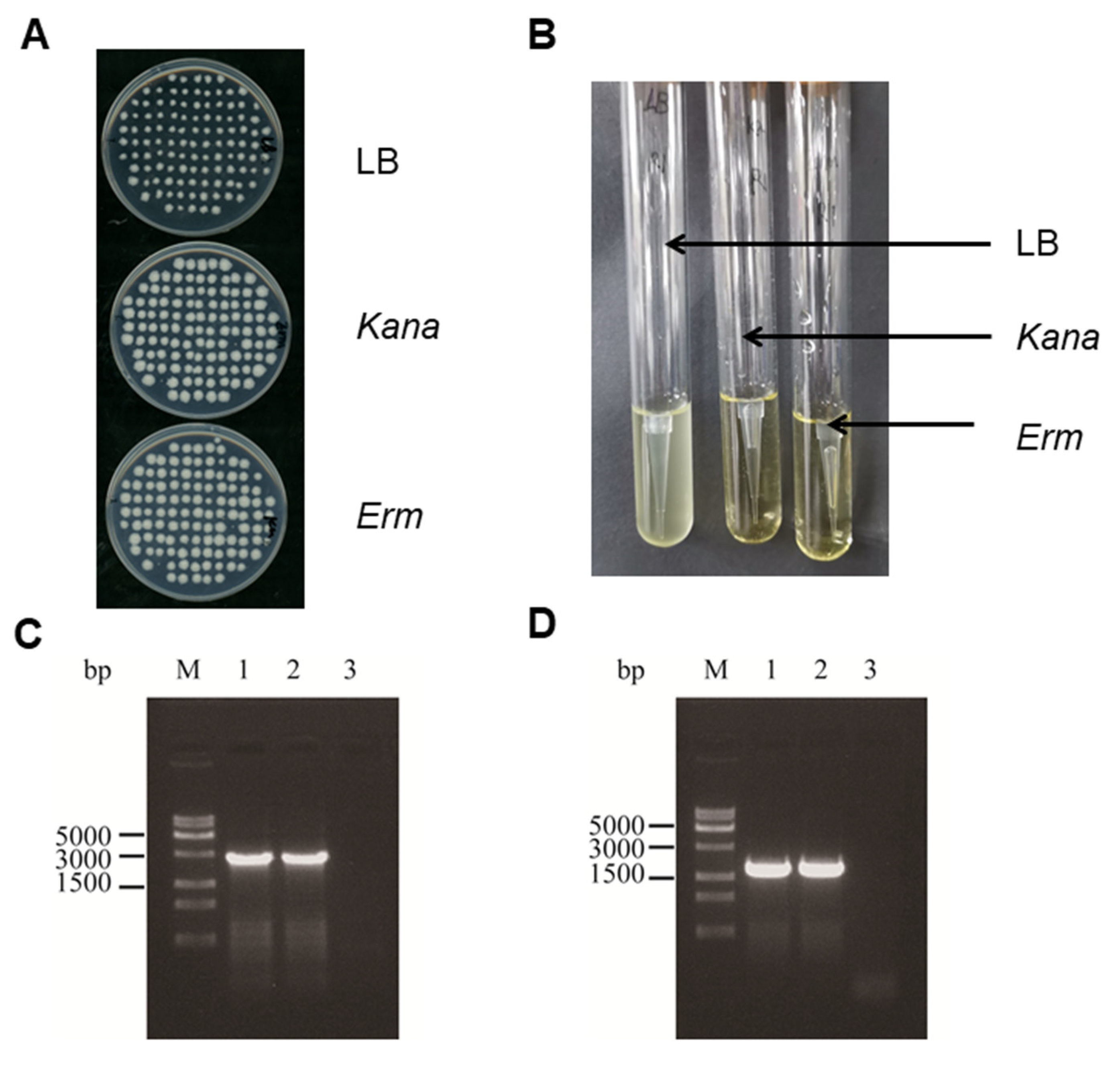
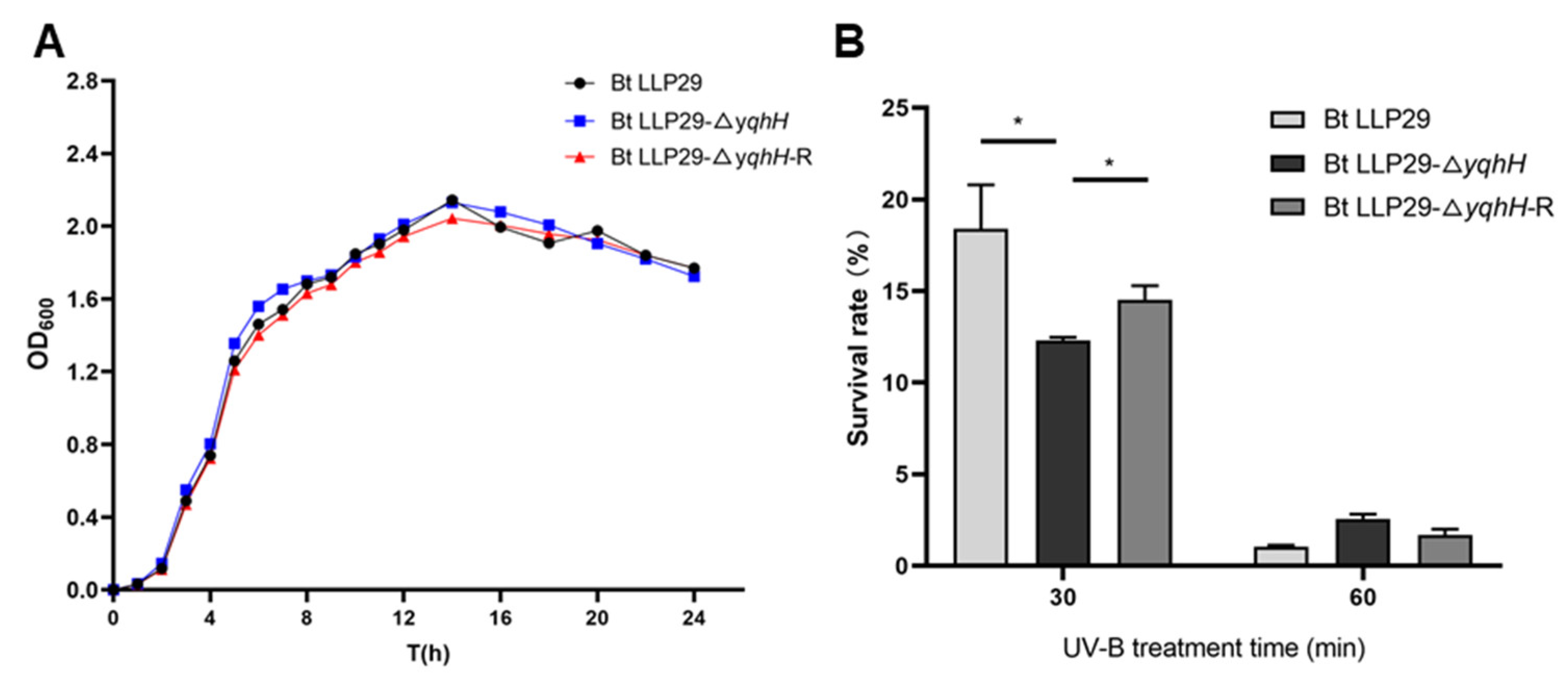
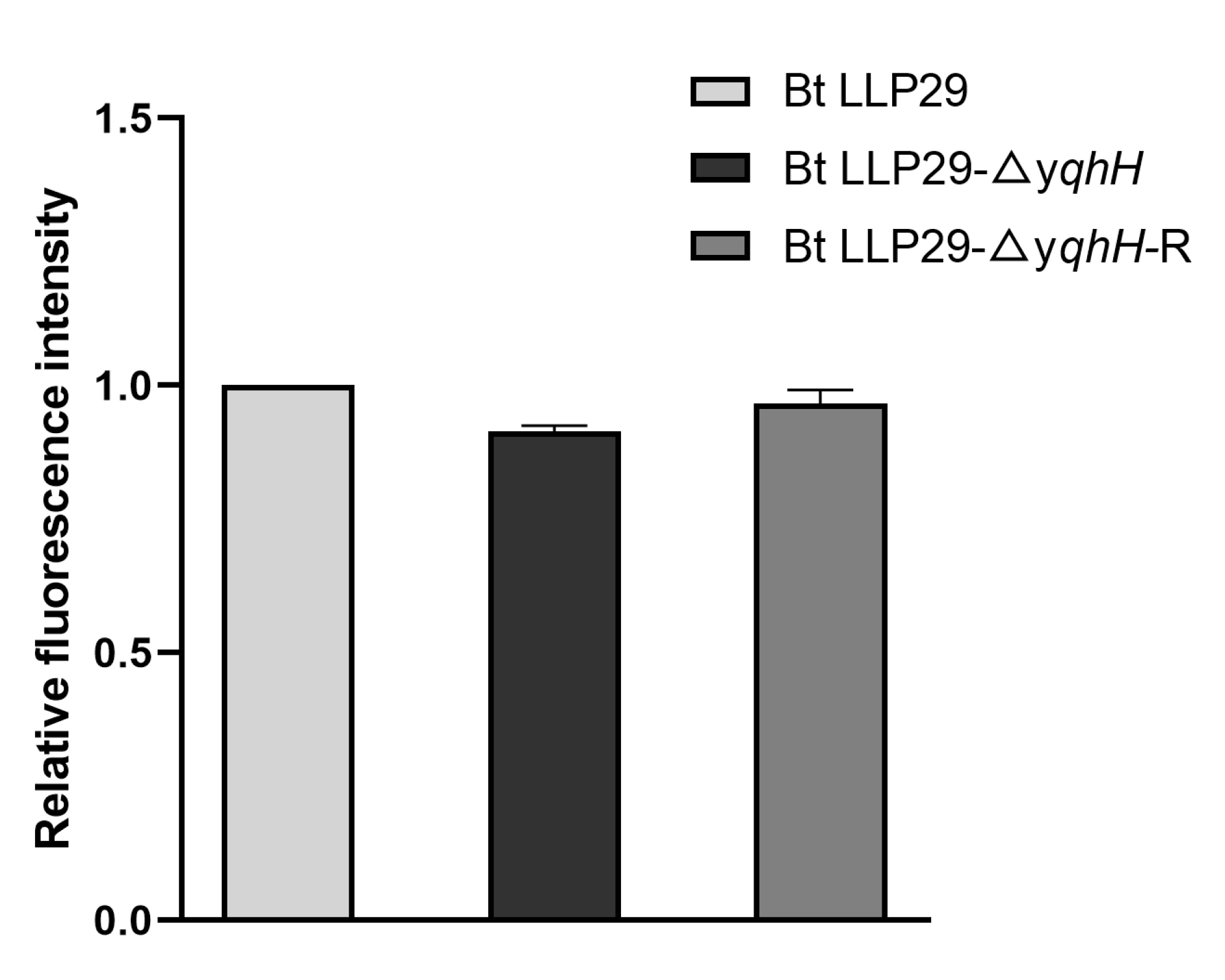
| Variation Type | Number of Variants | Sum |
|---|---|---|
| SNP annotation | ||
| Genome-wide heterozygous ratio (%) | 0.177 | |
| Total number of SNP loci | 1318 | |
| InDel annotation | ||
| Sum of insertion mutations | 14 | 31 |
| Total deletion mutation | 17 | |
| SV annotation | ||
| Deletion | 35 | 206 |
| Inversion | 145 | |
| inversion | 26 |
Disclaimer/Publisher’s Note: The statements, opinions and data contained in all publications are solely those of the individual author(s) and contributor(s) and not of MDPI and/or the editor(s). MDPI and/or the editor(s) disclaim responsibility for any injury to people or property resulting from any ideas, methods, instructions or products referred to in the content. |
© 2023 by the authors. Licensee MDPI, Basel, Switzerland. This article is an open access article distributed under the terms and conditions of the Creative Commons Attribution (CC BY) license (https://creativecommons.org/licenses/by/4.0/).
Share and Cite
Ma, W.; Guan, X.; Miao, Y.; Zhang, L. Whole Genome Resequencing Revealed the Effect of Helicase yqhH Gene on Regulating Bacillus thuringiensis LLP29 against Ultraviolet Radiation Stress. Int. J. Mol. Sci. 2023, 24, 5810. https://doi.org/10.3390/ijms24065810
Ma W, Guan X, Miao Y, Zhang L. Whole Genome Resequencing Revealed the Effect of Helicase yqhH Gene on Regulating Bacillus thuringiensis LLP29 against Ultraviolet Radiation Stress. International Journal of Molecular Sciences. 2023; 24(6):5810. https://doi.org/10.3390/ijms24065810
Chicago/Turabian StyleMa, Weibo, Xiong Guan, Ying Miao, and Lingling Zhang. 2023. "Whole Genome Resequencing Revealed the Effect of Helicase yqhH Gene on Regulating Bacillus thuringiensis LLP29 against Ultraviolet Radiation Stress" International Journal of Molecular Sciences 24, no. 6: 5810. https://doi.org/10.3390/ijms24065810
APA StyleMa, W., Guan, X., Miao, Y., & Zhang, L. (2023). Whole Genome Resequencing Revealed the Effect of Helicase yqhH Gene on Regulating Bacillus thuringiensis LLP29 against Ultraviolet Radiation Stress. International Journal of Molecular Sciences, 24(6), 5810. https://doi.org/10.3390/ijms24065810






